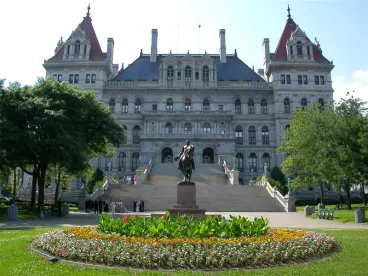Earlier today, the New York State Climate Action Council adopted the final scoping plan (“Plan”), which will serve as a roadmap to achieve the climate change mandates set forth in New York’s landmark climate law – the Climate Leadership and Community Protection Act (“CLCPA”). Enacted in 2019, the CLCPA codified several robust climate mandates for the State which must be achieved in an accelerated time frame. Specifically, New York is statutorily required to achieve:
-
An economy-wide 85% reduction in greenhouse gas (“GHG”) emissions by 2050;
-
70% renewable energy consumption by 2030 followed by a 100% zero-emission electric system by 2040; and
-
6,000 MW of solar by 2025, 9,000 MW of offshore wind by 2035, and 3,000 MW of energy storage by 2030.
The CLCPA established the Climate Action Council (“Council”), a 22-member committee tasked with developing the Plan to achieve the state’s clean energy and climate agenda. In December 2021, the Council released a draft plan that set forth a multi-year vision for a decarbonized energy future in New York and identified several sector-specific strategies. See E2 Law blog post. For the past year, the Council has held a series of informational forums, received public comments, and incorporated changes to the draft plan.
The CLCPA directs investment in disadvantaged communities (“DACs”) that have been disproportionately impacted by climate change, mandating that DACs receive at least 35% of overall benefits resulting from expenditures on clean energy and energy efficiency programs. The Council has included strategies in the Plan to manage environmental justice and equity concerns while facilitating an equitable transition for the workforce as the state transitions away from traditional energy resources and towards a green economy.
Given the CLCPA’s aggressive GHG emissions-reductions mandates, the Plan prescribes an “all hands on deck” approach to emissions reductions and provides strategies for all sectors of the economy. Key recommendations in the Plan include:
-
Aggressive deployment of clean energy resources such as land-based and offshore wind, hydropower, and solar as the primary sources of power generation across all sectors of New York’s economy by 2050. The Plan recommends investments in dispatchable zero-carbon resources, such as green hydrogen, energy storage, yet-to-be developed emissions-free resources and consideration of the need for ongoing State environmental attribute payments for existing, baseload zero-carbon nuclear facilities to provide continuing support for the Zero Emissions Credit program to ensure grid reliability and affordability. The Plan also highlights the need for transmission upgrades to unbottle renewable energy resources, reduce system congestion, and ensure the delivery of clean energy from Upstate and offshore generation sources to consumers in Southeastern New York.
-
Strategies to facilitate deployment of zero emissions vehicles (“ZEVs”). To achieve emissions reductions in the transportation sector, the Plan notes that most vehicles running on gasoline or diesel will need to be replaced with battery electric, hydrogen fuel cell, or other yet-to-be-developed zero-emission technologies over the next two decades. This transformation will necessitate a series of actions and incentives to influence consumer behaviors, such as requiring ZEV sales by 2035 and enhanced rebates for EV purchases. Barriers to access, such as the cost of ZEVs and availability of electric vehicle infrastructure, will need to be addressed, with a focus on DACs.
-
Adoption of a Clean Transportation Standard (also referred to as a “Low Carbon Fuel Standard” or “Clean Fuel Standard”) to reduce emissions by providing a market signal to encourage private investment in replacements for fossil fuels and promote transportation electrification. The proposed standard would require fossil fuel providers to finance vehicle electrification and support the use of alternative fuels such as bioenergy and hydrogen. To prioritize co-pollutant reductions in DACs, the Plan recommends that allocating credits generated from home-charging of electric vehicles to DACs and limiting eligibility of credits to those with lower co-pollutant emissions.
-
Decarbonization of building operations through a transition away from fossil fuel combustion with a focus on electrification and energy efficiency. The Plan recommends the adoption of all-electric State codes to restrict combustion of fossil fuels in new construction and large retrofits by 2025 for smaller buildings and by 2028 for buildings larger than three stories. In addition, the Plan recommends that the State consider statutory amendments to limit new natural gas connections for existing buildings by 2025. The Plan also includes recommendations for equipment standards to foster the use of modern technologies, such as heat pumps, that will be used in buildings as the state transitions to widespread electrification of the building sector.
-
Recommendations on the role alternative fuels (e.g., green hydrogen, renewable natural gas, and biofuels) should play in achieving GHG emissions reductions across the economy. Generally, the Plan prioritizes the use of alternative fuels for energy/heat intensive industries and applications that are challenging to electrify, and not as a substitute for widespread electrification.
-
Adoption of a cap and invest program across all sectors to reduce emissions and raise revenue for CLCPA implementation, with limitations on allowance trading in DACs to prevent the purchase of allowances that would increase emissions in those communities. The program would establish enforceable emission caps that decline annually, with specific caps for the 2030 and 2050 mandates established by the CLCPA. Allowances would be made available to emissions sources through an auction mechanism with prices based on the price/ton of GHG emissions. Certain sources would have specific compliance obligations. For instance, producers and distributors of fuels used for transportation and heating would purchase allowances equal to the carbon content for the fuels they produce or distribute, and sources in the waste sector (i.e., landfills) would be responsible for their emissions of GHGs, including fugitive methane. A cap and invest program would be promulgated through rulemaking designed to align with the existing Regional Greenhouse Gas Initiative program.
The Council’s adoption of the Plan is a significant milestone in implementing CLCPA requirements. While the Plan is not legally binding, and lacks detail in some key areas, it lays the foundation for State climate policy development and will likely engender new legislation and regulatory activity foster incremental State investment. Now that the Plan has been adopted, the CLCPA requires the Department of Environmental Conservation to adopt regulations to enforce emissions mandates consistent with the Plan, which must be promulgated by Jan. 1, 2024.
Doreen U. Saia also contributed to this article.








 />i
/>i
